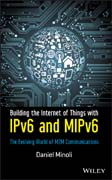
Building the Internet of Things with IPv6 and MIPv6: The Evolving World of M2M Communications
Minoli, Daniel
The Internet of Things(IoT) is an often–cited topic among researchers and practitioners. This essential book explains the concept and potential that the IoT presents, from mobile applications that allow home appliances to be programmed remotely, to solutions in manufacturing and energy conservation. Coverage features a tutorial for implementing the IoT using IPv6 and Mobile IPv6 and answers critical questions such as what is the IoT, how can it help my organization, what is the cost of deploying this system, and what are the security issues? INDICE: PREFACE xiii ABOUT THE AUTHOR xvii 1 WHAT IS THE INTERNET OF THINGS? 1 1.1 Overview and Motivations 1 1.2 Examples of Applications 12 1.3 IPv6 Role 17 1.4 Areas of Development and Standardization 20 1.5 Scope of the Present Investigation 23 Appendix 1.A: Some Related Literature 25 References 26 2 INTERNET OF THINGS DEFINITIONS AND FRAMEWORKS 28 2.1 IoT Definitions 28 2.1.1 General Observations 28 2.1.2 ITU–T Views 31 2.1.3 Working Definition 33 2.2 IoT Frameworks 38 2.3 Basic Nodal Capabilities 44 References 46 3 INTERNET OF THINGS APPLICATION EXAMPLES 48 3.1 Overview 49 3.2 Smart MeteringAdvanced Metering Infrastructure 52 3.3 e–HealthBody Area Networks 55 3.4 City Automation 62 3.5 Automotive Applications 64 3.6 Home Automation 67 3.7 Smart Cards 70 3.8 Tracking (Following and Monitoring Mobile Objects) 77 3.9 Over–The–Air–Passive SurveillanceRing of Steel 79 3.10 Control Application Examples 86 3.11 Myriad Other Applications 93 References 94 4 FUNDAMENTAL IoT MECHANISMS AND KEY TECHNOLOGIES 97 4.1 Identification of IoT Objects and Services 97 4.2 Structural Aspects of the IoT 101 4.2.1 Environment Characteristics 101 4.2.2 Traffic Characteristics 102 4.2.3 Scalability 102 4.2.4 Interoperability 103 4.2.5 Security and Privacy 103 4.2.6 Open Architecture 103 4.3 Key IoT Technologies 103 4.3.1 Device Intelligence 103 4.3.2 Communication Capabilities 104 4.3.3 Mobility Support 104 4.3.4 Device Power 105 4.3.5 Sensor Technology 107 4.3.6 RFID Technology 111 4.3.7 Satellite Technology 118 References 119 5 EVOLVING IoT STANDARDS 120 5.1 Overview and Approaches 120 5.2 IETF IPv6 Routing Protocol for RPL Roll 123 5.3 Constrained Application Protocol (CoAP) 126 5.3.1 Background 126 5.3.2 Messaging Model 129 5.3.3 RequestResponse Model 129 5.3.4 Intermediaries and Caching 129 5.4 Representational State Transfer (REST) 130 5.5 ETSI M2M 130 5.6 Third–Generation Partnership Project Service Requirements for Machine–Type Communications 131 5.6.1 Approach 131 5.6.2 Architectural Reference Model for MTC 134 5.7 CENELEC 135 5.8 IETF IPv6 Over Lowpower WPAN (6LoWPAN) 137 5.9 ZigBee IP (ZIP) 137 5.10 IP in Smart Objects (IPSO) 138 Appendix 5.A: Legacy Supervisory Control and Data Acquisition (SCADA) Systems 138 References 142 6 LAYER 12 CONNECTIVITY: WIRELESS TECHNOLOGIES FOR THE IoT 144 6.1 WPAN Technologies for IoTM2M 145 6.1.1 ZigbeeIEEE 802.15.4 155 6.1.2 Radio Frequency for Consumer Electronics (RF4CE) 170 6.1.3 Bluetooth and its Low–Energy Profile 170 6.1.4 IEEE 802.15.6 WBANs 180 6.1.5 IEEE 802.15 WPAN TG4j MBANs 181 6.1.6 ETSI TR 101 557 184 6.1.7 NFC 187 6.1.8 Dedicated Short–Range Communications (DSRC) and Related Protocols 189 6.1.9 Comparison of WPAN Technologies 192 6.2 Cellular and Mobile Network Technologies for IoTM2M 195 6.2.1 Overview and Motivations 195 6.2.2 Universal Mobile Telecommunications System 196 6.2.3 LTE 197 Appendix 6.A: Non–Wireless Technologies for IoT: Powerline Communications 209 References 216 7 LAYER 3 CONNECTIVITY: IPv6 TECHNOLOGIES FOR THE IoT 220 7.1 Overview and Motivations 220 7.2 Address Capabilities 224 7.2.1 IPv4 Addressing and Issues 224 7.2.2 IPv6 Address Space 225 7.3 IPv6 Protocol Overview 231 7.4 IPv6 Tunneling 239 7.5 IPsec in IPv6 242 7.6 Header Compression Schemes 242 7.7 Quality of Service in IPv6 245 7.8 Migration Strategies to IPv6 246 7.8.1 Technical Approaches 246 7.8.2 Residential Broadband Services in an IPv6 Environment 250 7.8.3 Deployment Opportunities 252 References 254 8 LAYER 3 CONNECTIVITY: MOBILE IPv6 TECHNOLOGIES FOR THE IoT 257 8.1 Overview 257 8.2 Protocol Details 266 8.2.1 Generic Mechanisms 267 8.2.2 New IPv6 Protocol, Message Types, and Destination Option 271 8.2.3 Modifications to IPv6 Neighbor Discovery 277 8.2.4 Requirements for Various IPv6 Nodes 278 8.2.5 Correspondent Node Operation 278 8.2.6 HA Node Operation 285 8.2.7 Mobile Node Operation 286 8.2.8 Relationship to IPV4 Mobile IPv4 (MIP) 291 References 292 9 IPv6 OVER LOW–POWER WPAN (6LoWPAN) 293 9.1 BackgroundIntroduction 294 9.2 6LoWPANs Goals 296 9.3 Transmission of IPv6 Packets Over IEEE 802.15.4 297 References 301 GLOSSARY 302 INDEX 356
- ISBN: 978-1-118-47347-4
- Editorial: Wiley–Blackwell
- Encuadernacion: Cartoné
- Páginas: 392
- Fecha Publicación: 23/08/2013
- Nº Volúmenes: 1
- Idioma: Inglés
